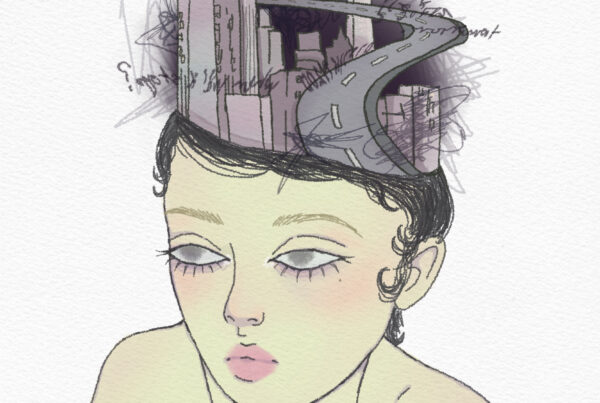
Harmony is being at peace with yourself, perhaps even having a certain amount of control over yourself and your environment; it reinforces safety and promotes a healthy consistent flow of thinking that keeps us grounded. Harmony means many things to many different people, but what does it mean to people who struggle with memory? People who suffer from dementia, amnesia; the fogginess of dissociation, those who cannot rely on their memory to go through with everyday motions? Rather than being in consistent peace with themselves, these people are liable to feel out of sync and disoriented when attempting to remember even the smallest of things.
Harmony is being at peace with yourself, perhaps even having a certain amount of control over yourself and your environment; it reinforces safety and promotes a healthy consistent flow of thinking that keeps us grounded. Harmony means many things to many different people, but what does it mean to people who struggle with memory? People who suffer from dementia, amnesia; the fogginess of dissociation, those who cannot rely on their memory to go through with everyday motions? Rather than being in consistent peace with themselves, these people are liable to feel out of sync and disoriented when attempting to remember even the smallest of things.

Photo by Jean Wimmerlin
As far as the human body and mind and its multifaceted miracle of functioning is concerned, the structure and process of memory is a rather interesting and complicated concept and yet an absolute core principle behind maintaining bodily harmony and peace. Everyone, at one point or another, has been at that debilitating and absolutely frustrating point in time where they are unable to remember a very small or larger detail, for example when your head goes blank during an exam or if you walk into a room having forgotten your original purpose for having ever entered it in the first place. Applying the core of this example of frustration derived from memory-related struggles to a broader view of everyday life and functioning may help us realise, acknowledge and appreciate our memory and how advantageous it is to be able to recall memory successfully at will. It also raises a certain awareness of how those who suffer from Alzheimer’s, Dementia, PTSD, and even minor memory loss from brain injuries face the consequences of not being able to recall or form new facts or even sometimes crucial facts about themselves and how to function in daily life and how it impairs their daily life. These deteriorations (Ricker et al., 2016) of memory can disorganise and disorientate a person and their thoughts, resulting in stress and ultimately being thrown off balance. This can impair daily life functioning and even basic safety functions. One of the many questions we can ask ourselves after valuing the normal functioning of our memory is how we can enhance or protect it. One of the many mental exercises or skills we can look at is building a memory palace, a mental journey as a sort of archive for all of our memories as a cumulative whole where they are easily accessible.
In order to help those with serious memory impairments as a result of injury, old age, or any such memory impairing diseases, an approach separate from the usual prescriptive route could be cognitive strengthening exercises; there are many exercises, as well as lifestyle changes that can be introduced to help stabilise, improve and strengthen memory, one of them being the construction of a memory palace in the mind.
“Understanding how a certain process works and produces a result can help us learn how to act upon it, and enhance and improve it.”
What is a memory palace?
A memory palace is an imaginary location in your mind where you can store mnemonic (a system such as a pattern of letters, ideas, or associations that aids the memory and in remembering things) images. Usually, memory palaces involve making a mental journey through a place you know well, like a house, building, or town. Along this mental journey in your new mind “palace”, you will visit specific locations in a fixed order everytime. These locations will be associated with something you link to the subject you are trying to memorise. It could be a childhood memory, maths formulae for a test, or even people. Each specific location (like a door that opens into a small room) is responsible for holding a specific piece of information you are trying to memorise or understand. This method is often also referred to as the method of loci, i.e locating your memories as physical objects, easy to remember from within your mental landscape. The memory palace technique is quite an old technique. In fact, it dates back to ancient Romans and Greek rhetorical treatises. The Roman writer Cicero first described this technique in his writings on rhetoric, called De Oratore. Cicero claimed this method originated from the Greek poet Simonides. This method is sometimes referred to as the Journey Method, the Roman Room or the Pegword Method.
Understanding how a certain process works and produces a result can help us learn how to act upon it, and enhance and improve it. The process of memory, how it is encoded and stored as well as recalled, is a delicately complex and solid process that we should all take the time to learn about.
There are three main processes that characterise how memory works. These processes are encoding, storage, and retrieval (or recall). When we receive sensory input, it needs to be changed into a form that is compatible with our internal system in order for it to be stored, this process is called encoding. Memory can be encoded as visual, acoustic, and semantic. After being encoded, the mind must now appropriately store the memory based on potential accessibility, hence it goes into either our long-term (LTM) or short-term memory (STM) storage. Now that we know how memory is stored we can move on to how we are able to recall it or retrieve it; this is where the differences between short-term and long-term memory become clear: STM is stored and retrieved sequentially (by forming or following a logical order or sequence), LTM is stored and retrieved by association. As far as association goes, another interesting area of memory study is the codependency and relation of memory and smell (Can and Ross, 1989). Organising memory can aid retrieval, which is our main goal; to enhance the accuracy and ability of memory retrieval.
“Enhancing appropriate memory retrieval may even have a positive effect on trauma processing, decreasing the unwanted resurfacing of traumatic memories and the stress that accompanies it.”
Disorganised memory retrieval may result in unwanted memories resurfacing (usually as a result of an upsetting or trauma-related experience) and this can cause as much stress as being unable to recall a wanted memory. In fact, it can cause even more stress. Any stress caused by not being able to recall or accidentally recalling an unpleasant or intrusive memory can present as physiological symptoms such as muscle tension and associated hypertension or even panic attacks. Not only does this predicament cause the mind to scramble itself in panic, but the body is also affected very regularly (Boals et al., 2008). Enhancing appropriate memory retrieval may even have a positive effect on trauma processing, decreasing the unwanted resurfacing of traumatic memories and the stress that accompanies it. These memory problems contribute to disorders or episodes of mental distress such as depression as well (specifically reduced autobiographical memory). Inappropriate Stress, as a trigger of multiple physiological and medical conditions, causes many problems. For example High levels of the stress hormone cortisol cause your brain to literally shrink and age prematurely, leading to short-term memory loss among many other factors; and sometimes having a scrambled, jumbled mind can cause that stress which ends up being an endless loop. Organising your memories with such a method can help decrease memory loss and stress related to forgetfulness.
There are many methods like this, methods of the mind that can also on a lighter note add more colour to the otherwise mundane activity of having to learn the material to the point of memorising it, especially for us students. The scope for expanding it in order to help us develop strengthened cognitive abilities is also rather promising. At a fairly objective level, it can help to give structure to mental processing and keeps the brain from tangles resulting in better internal communication which entails not only the functioning of the body from within but the communication we hold within ourselves and understanding of the self which in turn helps promote a healthy consistent flow of peace and harmony. Our human bodies in a way are like machines and such balance helps keep them well oiled and functioning optimally.<<
There are further readings for viewing this concept under terms of literature and practical application and a multitude of other instances where it has been mentioned;
- The Memory Palace of Matteo Ricci by Jonathan D. Spence (book)
- The Art Of Memory by Frances Yates
- On the Shadows of Ideas by Giordano Bruno
- Moonwalking with Einstein by Joshua Foer
- De Oratore cicero 55 BC
References
-Cann, A., & Ross, D. A. (1989). Olfactory stimuli as context cues in human memory. The American Journal of Psychology, 102(1), 91–102. https://doi.org/10.2307/1423118
-Boals A, Rubin DC, Klein K. Memory and coping with stress: the relationship between cognitive-emotional distinctiveness, memory valence, and distress. Memory. 2008;16(6):637-57. doi: 10.1080/09658210802083098. PMID: 18569690; PMCID: PMC3076307.
-Ricker, T. J., Vergauwe, E., & Cowan, N. (2016). Decay theory of immediate memory: From Brown (1958) to today (2014). Quarterly journal of experimental psychology (2006), 69(10), 1969–1995. https://doi.org/10.1080/17470218.2014.914546
-Dalgleish, T., & Werner-Seidler, A. (2014). Disruptions in autobiographical memory processing in depression and the emergence of memory therapeutics. Trends in cognitive sciences, 18(11), 596-604. doi: 10.1016/j.tics.2014.06.010.
-Raes, F., Hermans, D., de Decker, A., Eelen, P., & Williams, J. M. G. (2003). Autobiographical memory specificity and affect regulation: an experimental approach. Emotion, 3(2), 201. doi:10.1037/1528-3542.3.2.201
As far as the human body and mind and its multifaceted miracle of functioning is concerned, the structure and process of memory is a rather interesting and complicated concept and yet an absolute core principle behind maintaining bodily harmony and peace. Everyone, at one point or another, has been at that debilitating and absolutely frustrating point in time where they are unable to remember a very small or larger detail, for example when your head goes blank during an exam or if you walk into a room having forgotten your original purpose for having ever entered it in the first place. Applying the core of this example of frustration derived from memory-related struggles to a broader view of everyday life and functioning may help us realise, acknowledge and appreciate our memory and how advantageous it is to be able to recall memory successfully at will. It also raises a certain awareness of how those who suffer from Alzheimer’s, Dementia, PTSD, and even minor memory loss from brain injuries face the consequences of not being able to recall or form new facts or even sometimes crucial facts about themselves and how to function in daily life and how it impairs their daily life. These deteriorations (Ricker et al., 2016) of memory can disorganise and disorientate a person and their thoughts, resulting in stress and ultimately being thrown off balance. This can impair daily life functioning and even basic safety functions. One of the many questions we can ask ourselves after valuing the normal functioning of our memory is how we can enhance or protect it. One of the many mental exercises or skills we can look at is building a memory palace, a mental journey as a sort of archive for all of our memories as a cumulative whole where they are easily accessible.
In order to help those with serious memory impairments as a result of injury, old age, or any such memory impairing diseases, an approach separate from the usual prescriptive route could be cognitive strengthening exercises; there are many exercises, as well as lifestyle changes that can be introduced to help stabilise, improve and strengthen memory, one of them being the construction of a memory palace in the mind.
“Understanding how a certain process works and produces a result can help us learn how to act upon it, and enhance and improve it.”
What is a memory palace?
A memory palace is an imaginary location in your mind where you can store mnemonic (a system such as a pattern of letters, ideas, or associations that aids the memory and in remembering things) images. Usually, memory palaces involve making a mental journey through a place you know well, like a house, building, or town. Along this mental journey in your new mind “palace”, you will visit specific locations in a fixed order everytime. These locations will be associated with something you link to the subject you are trying to memorise. It could be a childhood memory, maths formulae for a test, or even people. Each specific location (like a door that opens into a small room) is responsible for holding a specific piece of information you are trying to memorise or understand. This method is often also referred to as the method of loci, i.e locating your memories as physical objects, easy to remember from within your mental landscape. The memory palace technique is quite an old technique. In fact, it dates back to ancient Romans and Greek rhetorical treatises. The Roman writer Cicero first described this technique in his writings on rhetoric, called De Oratore. Cicero claimed this method originated from the Greek poet Simonides. This method is sometimes referred to as the Journey Method, the Roman Room or the Pegword Method.
Understanding how a certain process works and produces a result can help us learn how to act upon it, and enhance and improve it. The process of memory, how it is encoded and stored as well as recalled, is a delicately complex and solid process that we should all take the time to learn about.
There are three main processes that characterise how memory works. These processes are encoding, storage, and retrieval (or recall). When we receive sensory input, it needs to be changed into a form that is compatible with our internal system in order for it to be stored, this process is called encoding. Memory can be encoded as visual, acoustic, and semantic. After being encoded, the mind must now appropriately store the memory based on potential accessibility, hence it goes into either our long-term (LTM) or short-term memory (STM) storage. Now that we know how memory is stored we can move on to how we are able to recall it or retrieve it; this is where the differences between short-term and long-term memory become clear: STM is stored and retrieved sequentially (by forming or following a logical order or sequence), LTM is stored and retrieved by association. As far as association goes, another interesting area of memory study is the codependency and relation of memory and smell (Can and Ross, 1989). Organising memory can aid retrieval, which is our main goal; to enhance the accuracy and ability of memory retrieval.
“Enhancing appropriate memory retrieval may even have a positive effect on trauma processing, decreasing the unwanted resurfacing of traumatic memories and the stress that accompanies it.”
Disorganised memory retrieval may result in unwanted memories resurfacing (usually as a result of an upsetting or trauma-related experience) and this can cause as much stress as being unable to recall a wanted memory. In fact, it can cause even more stress. Any stress caused by not being able to recall or accidentally recalling an unpleasant or intrusive memory can present as physiological symptoms such as muscle tension and associated hypertension or even panic attacks. Not only does this predicament cause the mind to scramble itself in panic, but the body is also affected very regularly (Boals et al., 2008). Enhancing appropriate memory retrieval may even have a positive effect on trauma processing, decreasing the unwanted resurfacing of traumatic memories and the stress that accompanies it. These memory problems contribute to disorders or episodes of mental distress such as depression as well (specifically reduced autobiographical memory). Inappropriate Stress, as a trigger of multiple physiological and medical conditions, causes many problems. For example High levels of the stress hormone cortisol cause your brain to literally shrink and age prematurely, leading to short-term memory loss among many other factors; and sometimes having a scrambled, jumbled mind can cause that stress which ends up being an endless loop. Organising your memories with such a method can help decrease memory loss and stress related to forgetfulness.
There are many methods like this, methods of the mind that can also on a lighter note add more colour to the otherwise mundane activity of having to learn the material to the point of memorising it, especially for us students. The scope for expanding it in order to help us develop strengthened cognitive abilities is also rather promising. At a fairly objective level, it can help to give structure to mental processing and keeps the brain from tangles resulting in better internal communication which entails not only the functioning of the body from within but the communication we hold within ourselves and understanding of the self which in turn helps promote a healthy consistent flow of peace and harmony. Our human bodies in a way are like machines and such balance helps keep them well oiled and functioning optimally.<<
There are further readings for viewing this concept under terms of literature and practical application and a multitude of other instances where it has been mentioned;
- The Memory Palace of Matteo Ricci by Jonathan D. Spence (book)
- The Art Of Memory by Frances Yates
- On the Shadows of Ideas by Giordano Bruno
- Moonwalking with Einstein by Joshua Foer
- De Oratore cicero 55 BC



